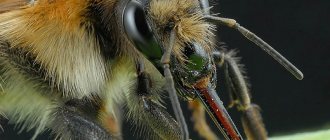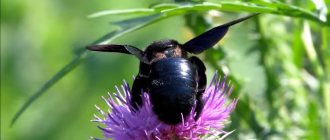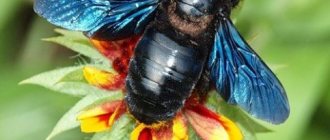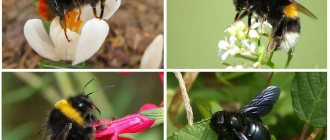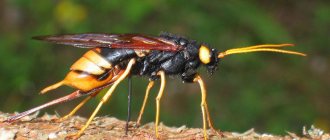The bumblebee (lat. Bombus) is an arthropod insect belonging to the family of bees and the genus Hymenoptera, one of its largest representatives. Bumblebees tolerate cold well, as during flight they develop a speed of up to 5 meters per second and produce energy, which is transformed into maintaining a constant body temperature of about 40 degrees; in extreme heat, they release a drop of liquid from their mouth and cool their head. This allows insects to collect pollen from plants early in the morning, when the air has not yet warmed up, which is a big advantage compared to bees.
An important fact is that regardless of their modest weight, bumblebees, just like ants, are capable of carrying heavy loads. A little earlier, scientists even assumed that from the point of view of physics they should not fly because of the proportions of their body and wings, but later this statement was refuted.
The bumblebee family is very social. They communicate using verbal and non-verbal communication, pheromones and wing movements. These methods convey information about nest safety, new food sources, and defense strategies.
Description
Bumblebees belong to the class of arthropod winged insects and are a type of bee. The original name of the genus in Latin is “Bombus”. Creatures are widespread on Earth, living in all corners of the planet where there are suitable living conditions. Now zoologists know about 300 different varieties of insects, which belong to fifty subspecies.
The two most common types of bumblebees are Bombus terrestris and Bombus lapidarius. They live in most countries.
Back view of bumblebee
You can distinguish a bumblebee from other bees by its large size and rounded contours of its body. Thanks to the hairs on their body, they adapt well to cold climates and do not freeze. They are also considered warm-blooded insects. When moving quickly, their body begins to generate heat, and the internal temperature can reach forty degrees.
People have a stereotype that a bumblebee bite is very painful, and in general it is better to beware of insects.
Such fears arose due to the large size of the creature and powerful jaws. However, in fact, this type of bee is the most peaceful and harmless. Interesting fact : the sting of a bumblebee is smooth and does not have serrations, unlike a bee's.
If the latter retains it in the victim, then the bumblebee, having made a bite, can pull it back into the body and fly away. Bumblebees never attack first. They do not use their jaws as weapons, despite their power, and their only defense is their stinger. But the individual will use it if there is no other way out. Moreover, only females and insects that build a hive have it. Ordinary males do not have a sting and are almost completely defenseless. In nature, the bumblebee brings great benefits by pollinating a large number of flowers.
Making a house for bumblebees with your own hands
A bumblebee house is often made from improvised materials, because the finished product is not particularly complex in design. In most cases, this is a regular wooden box with some additional elements to ensure the bees' comfort. The method for making such a hive is presented below.
Required materials and tools
To create the six simplest designs you will need:
- rough boards, the thickness of which reaches from 2.5 cm to 3 m;
- cut from centimeter plywood 15x15 cm - 2 pieces;
- strips with a cross section of 1.5×1.5 cm - 4 pieces;
- drill;
- insulation material in the form of tow or moss;
- a piece of foam plastic measuring 15x15 cm.
Instead of the specified insulating material, other varieties with the same properties can be prepared. The sizes of bumblebees may also differ, but then the specified amount of material will be enough for fewer boxes.
Find out what to do if you are stung by a bumblebee.
Step-by-step instruction
The process of making hives using these materials involves the following steps:
- To begin, cut the prepared boards and put them together into a box 15x15x15 cm.
- Nail the bottom from cut plywood to the structure, and attach 4 strips to another similar part to form a “overlap” lid.
- In the front wall of the hive (approximately in the middle), drill 2 holes with a diameter of 1.8 cm each. Leave one open, and make the other blind by sealing it with a cork.
- Insulate the interior space with moss or tow, filling 1/3 of the entire volume of the box with it.
- Place the cut piece of foam plastic under the bottom of the bumblebee house.
Ready-made hives can be placed on 30-centimeter stakes and placed in the garden next to flowering plants in early May. In this case, the holes of the tapholes should “look” at the southern part of the site.
Important! Captured females (they are larger than males) are placed in such hives, and then the entrances are closed for a day. If they like the place, they will soon bring the rest of the family members, otherwise they will have to look for other individuals
Appearance and features
Yellow pollen on the black stripes of a bumblebee
A bumblebee has a massive body compared to other bees. Impressive dimensions are achieved due to developed pectoral muscles. They also serve as an additional source of heat along with the fluff. In cool weather, the insect begins to intensively contract its muscles, thereby increasing body temperature. This helps to warm up the body and go to pollinate flowers earlier than other types of bees.
On the sides of the body there are three pairs of limbs: two small legs in front and four large ones coming from the center. Bumblebees fly thanks to two wings located on the front of the body.
Bumblebees are black in color, with two yellow stripes on top: at the head and under the wings. There is also a white stripe in the sting area. The entire body is covered with small hairs, which determine the color pattern.
The head is quite small in relation to the body. At the top there are two long antennae planted next to the eyes. In front there is a powerful jaw, inside of which a long tongue is hidden.
Depending on the type, the insect can be of different sizes. Steppe bumblebees are the largest and can grow up to 3.5 cm in length. In common species, males reach up to 2.5 cm. Females are larger: their length reaches 2.9 cm. The body weight of males does not exceed 0.6 g , but for women it often exceeds 0.8 g.
Sex differences
The female's head has a slightly elongated shape and is somewhat rounded at the back of the head. As for males, their heads are almost round or triangular. In addition, in males you can see a dotted line that runs along the front and crown. Females also differ in that their upper lip is rectangular in shape and has strongly curved mandibles that overlap when closed. Males have quite powerful mouthparts that allow them to gnaw through the stems of blades of grass.
In females, regardless of the species, the sixth sternite is without characteristic ridges, and in males there is no median eminence on the second sternite. The abdomen of females always ends with a multiple action sting. This means that it does not have the characteristic barbs like a bee, and the female can easily pull it out of the victim’s body after a sting. As for the males, they do not have a stinger, which means that males do not bite. Instead of a sting, males have genitals in this place, well covered with a chitinous layer of a dark brown hue.
Males do not have baskets on their hind legs that serve to collect pollen, but they have maximum pubescence, the degree of which depends on the type of insect.
It is important to know! Female insects are divided into 2 categories: workers, who are busy collecting pollen, or queens, who are busy reproducing the family.
The Secret Life of Bumblebees
Where does the bumblebee live?
Habitat of bumblebees
Due to their good adaptation to environmental conditions, bumblebees live in almost all corners of the planet. Exceptions are places where there is very little vegetation, as well as in hot climates. At high temperatures, the insect begins to feel uncomfortable due to the fact that its body already generates a lot of heat during activities.
In some places the number of bumblebees is small. For example, the Arctic Circle is home to small populations of individual species adapted to cold climates and capable of pollinating local vegetation. In Greenland, Alaska and Chukotka they can only be found in alpine meadows. Small populations also occur in lands with a tropical climate.
Interesting fact : in some countries, gardeners specially breed garden bumblebees to increase productivity.
Most species of bumblebees live in Russia, Europe, Asia and America. They enjoy the local climate and abundant vegetation. Not so long ago, insects were specially brought to Australia, to the state of Tasmania. There they are used to increase the yield of clover, and bumblebees cope with their task with five points. And their peacefulness simplifies the process of using them.
Interesting: Mosquito: description, nutrition, habits, why they bite, reproduction, types, photos and videos
Lifestyle and nutrition
The whole life of a bumblebee revolves around flowers and offspring. The queen begins spring by choosing a shelter for her nest. Most often these are burrows. The queen mother usually looks for a free burrow in a well-warmed area, but sometimes chases away a mouse or other host. The female creates a microclimate in the nest. Water should not flow into it. The temperature regime is also vital for the development of larvae.
The home should be neither hot nor cold. In hot weather, bumblebees work like fans, blowing pupae and larvae with rapid movements of their wings.
Moss, grass, and wool are used in construction. Species such as meadow, horse and rock bumblebees build nests both underground and on the ground. Other species prefer to nest in hollows, birdhouses, and secluded places in human buildings. To strengthen and camouflage the nest, wax is used, which is secreted by the abdominal glands. The queen collects wax with her paws, chews it and then uses it.
Once settled, the queen places the eggs and a mixture of honey and pollen into a closed wax capsule. When the larvae eat the food, it gnaws a hole for them to feed further. At the same time, new capsules are built, eggs are laid again and again. Working individuals collect nectar all day, even in light rain, to feed their younger brothers and sisters. They are even able to replace the queen if she dies and lay eggs, from which only males emerge. Over the summer, the family grows to 100 - 200 insects, sometimes up to 500. In artificial heated houses, the family can grow to a thousand individuals.
The larvae feed on fresh nectar and honey. Bumblebee honey differs from bee honey:
- contains more water, more liquid;
- not so sweet;
- does not store for the winter;
- less fragrant.
Attention! In fiction, cases are sometimes described as something ordinary when children or adults feast on bumblebee honey. Now there are fewer bumblebees. Their nests cannot be destroyed. There is no need to become another enemy of this noble insect.
The number of bumblebees is reduced:
- use of chemical plant protection products;
- overgrazing;
- spring burning of dry grass;
- disorderly recreational use of natural areas (mass events, etc.);
- destruction of nests during haymaking and cultivation of meadows.
Adults eat nectar and pollen. The highest density of insects is observed on rich honey plants. Clover is preferred. In early spring, primroses and shrubs of the willow family are of great importance for nutrition.
Habitat and lifestyle of bumblebees
Bumblebees settle where the plants they are interested in grow.
Since several hundred species of bumblebees live on Earth, each has certain characteristics depending on environmental conditions and habits.
Bombus terrestris lives in Africa. It is black in color with small white spots on its belly. These bumblebees build their hives in the ground; this is done by the workers.
Bombus lapidarius is common in Europe. On its black body there are red-orange stripes, by which it is easy to distinguish it from other representatives of bees. If the African type of insects grows up to three centimeters, then this one is usually no more than two in length. They build their nests on rocks. This species is also characterized by cannibalism: females often feed males to their larvae.
A bumblebee collects pollen and nectar using its proboscis
Regardless of the species, bumblebees live in flocks and have a clear division into roles: queen, males and workers. The queen actively participates in the life of the nest and gives birth to offspring. Males and workers are engaged in approximately the same activities, but the former pay more attention to pollinating flowers, the latter - to expanding and strengthening the house. While bees try to carefully design the nest, planning entrances and internal structure, bumblebees often neglect this. Their houses look shapeless, as if they were made in haste. The material used is fur and wax, which are simply piled up and tunnels are dug inside.
Interesting fact : in order not to build a nest, bumblebees can occupy a mouse hole, driving out the previous occupant.
Bumblebees are very hardworking and go out every day to pollinate flowers. At the beginning of the day, the queen climbs onto the roof of the nest and begins to make loud sounds, thereby awakening all members of the flock from sleep. Having woken up, the insects go to work.
Wintering of insects
When studying the life features of these insects, you need to know how the bumblebee winters in order to clearly understand its life cycle. The bumblebee family lives only during the summer; only the young queens remain for the winter. But after hibernation it is difficult to see them, since they have been building their new nest since early spring. In arranging a new home, all available materials are used: moss, dry grass, fluff. It is still cold outside, so the female needs to actively flap her wings to maintain her body temperature. The nests must be completely ready before the eggs are laid.
New individuals emerge from the laid eggs and collect nectar, pollen and expand nests. In the fall, the entire family dies, except for the young fertilized queens, which will spend the winter, and in the new spring they will begin the life cycle of bumblebees in a new circle.
Only young queens remain for the winter
The answer to the question of where bumblebee queens spend the winter is ambiguous. Insects look for secluded places: cracks in trees, burrows, hollows, cracks in the walls of houses and other buildings. If a suitable reliable place is not found, the female can dig a hole in the soil on her own. When it gets cold, the insect falls into a state of torpor and remains there until the weather warms up in the spring. The state of sleep or torpor is a state similar to how bumblebees hibernate in nature.
On a note. Not all fertilized females survive winter. As numerous studies have shown, only a third of the representatives who fall asleep wake up in winter and begin building new homes.
What does a bumblebee eat?
Clover is the favorite delicacy of bumblebees.
Perhaps these creatures are the most finicky of the bee order in terms of food. If wasps can eat jam, honey, tree sap and other sweets, then bumblebees have only pollen and nectar in their diet. However, the list of plants from which they collect food is very long. They pollinate almost all flowers that grow in their habitats. It is often used in gardening. If a beehive has appeared next to the garden, there is no doubt that in the near future there will be a large harvest in the garden beds.
The larvae also need food, so upon returning to the nest, individuals try to bring as much nectar as possible, which serves as food for future offspring. If necessary, the cubs are also fed home-produced honey.
The bumblebee's favorite flower is clover. He is attracted by the smell and color of the plant, and as he flies past he cannot resist. It has also been noticed that bumblebees, just like other bees, are more willing to sit on bright buds than on those that have faded colors. However, if there is no other vegetation nearby, the insect will not hesitate to land on them.
What do they eat?
Bumblebees feed on flower nectars and pollen. They devote the whole day to this process. During intensive egg laying or queen feeding of larvae, workers carry food into the hive.
On a note! The most attractive nectar for bumblebees is a treat from clover flowers. However, the diet of insects includes many plants, which is why they are called universal pollinators.
For food, bumblebees choose flowers of bright, rich colors, but they do not disdain tree sap. When plants fly around, seeds are dispersed, which increases the yield of crops and herbs. Still, the diet is somewhat limited. Insects do not eat fruit juice, sugar syrup, or jam.
Character traits
Bumblebees are friendly and peaceful animals.
Bumblebees live in small flocks. Often the total number of individuals does not exceed hundreds. They are divided into large queens, responsible for the production of offspring, into males, and into small worker insects. Despite the developed social structure, the individual is not attached to the nest and at a certain moment may not return to it and find a new home, joining another flock. Moreover, this is mainly done by males who have already helped females with the production of offspring.
Interesting: Bear
